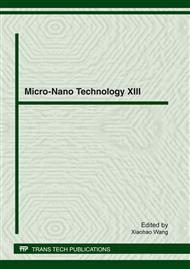p.334
p.341
p.348
p.354
p.359
p.369
p.375
p.381
p.386
Numerical Simulation of Multi-Physical Fields Coupling and Design of a Digital Microfluidics Chip
Abstract:
Due to its simple structure, low consumption of energy but strong driving forces, Electrowetting on Dielectric (EWOD) is used most frequently in digital microfluidics for manipulation and control of droplets. In this paper, the internal mechanism of EWOD is explained though establishing the geometric model of the unipolar board structure digital microfluidic chip. And the boundary conditions of equations are determined. Three coupling physical fields: electric field, flow field and temperature field in the digital microfluidic chip are simulated and analyzed. With the electric field equation coupled, Navier-Stokes equations and energy equation of the temperature control, the numerical simulation of the chip is conducted. The results show that the internal flow of micro-droplets is counterclockwise and swirling flow. The external flow velocity of micro-droplet is greater than the internal velocity. In addition, micro-droplets near the electrode applied temperature are higher than the internal temperature. Surface micromachining technologies are employed to fabricate the chip. Experimental results show that the droplet can be driven in a velocity of 25cm/s. It will possibly provide an effective solution to the manipulation of droplets.
Info:
Periodical:
Pages:
359-365
Citation:
Online since:
February 2012
Authors:
Keywords:
Price:
Сopyright:
© 2012 Trans Tech Publications Ltd. All Rights Reserved
Share:
Citation:


